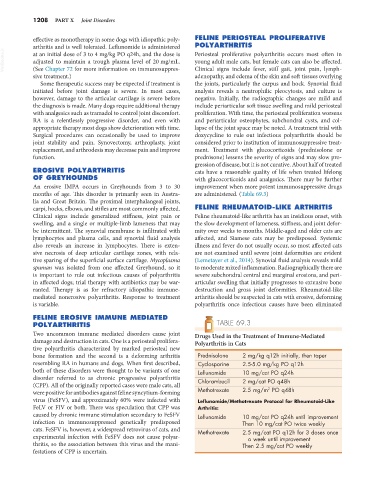Page 1236 - Small Animal Internal Medicine, 6th Edition
P. 1236
1208 PART X Joint Disorders
effective as monotherapy in some dogs with idiopathic poly- FELINE PERIOSTEAL PROLIFERATIVE
arthritis and is well tolerated. Leflunomide is administered POLYARTHRITIS
VetBooks.ir at an initial dose of 3 to 4 mg/kg PO q24h, and the dose is Periosteal proliferative polyarthritis occurs most often in
young adult male cats, but female cats can also be affected.
adjusted to maintain a trough plasma level of 20 mg/mL.
(See Chapter 72 for more information on immunosuppres-
adenopathy, and edema of the skin and soft tissues overlying
sive treatment.) Clinical signs include fever, stiff gait, joint pain, lymph-
Some therapeutic success may be expected if treatment is the joints, particularly the carpus and hock. Synovial fluid
initiated before joint damage is severe. In most cases, analysis reveals a neutrophilic pleocytosis, and culture is
however, damage to the articular cartilage is severe before negative. Initially, the radiographic changes are mild and
the diagnosis is made. Many dogs require additional therapy include periarticular soft tissue swelling and mild periosteal
with analgesics such as tramadol to control joint discomfort. proliferation. With time, the periosteal proliferation worsens
RA is a relentlessly progressive disorder, and even with and periarticular osteophytes, subchondral cysts, and col-
appropriate therapy most dogs show deterioration with time. lapse of the joint space may be noted. A treatment trial with
Surgical procedures can occasionally be used to improve doxycycline to rule out infectious polyarthritis should be
joint stability and pain. Synovectomy, arthroplasty, joint considered prior to institution of immunosuppressive treat-
replacement, and arthrodesis may decrease pain and improve ment. Treatment with glucocorticoids (prednisolone or
function. prednisone) lessens the severity of signs and may slow pro-
gression of disease, but it is not curative. About half of treated
EROSIVE POLYARTHRITIS cats have a reasonable quality of life when treated lifelong
OF GREYHOUNDS with glucocorticoids and analgesics. There may be further
An erosive IMPA occurs in Greyhounds from 3 to 30 improvement when more potent immunosuppressive drugs
months of age. This disorder is primarily seen in Austra- are administered. (Table 69.3)
lia and Great Britain. The proximal interphalangeal joints,
carpi, hocks, elbows, and stifles are most commonly affected. FELINE RHEUMATOID-LIKE ARTHRITIS
Clinical signs include generalized stiffness, joint pain or Feline rheumatoid-like arthritis has an insidious onset, with
swelling, and a single or multiple-limb lameness that may the slow development of lameness, stiffness, and joint defor-
be intermittent. The synovial membrane is infiltrated with mity over weeks to months. Middle-aged and older cats are
lymphocytes and plasma cells, and synovial fluid analysis affected, and Siamese cats may be predisposed. Systemic
also reveals an increase in lymphocytes. There is exten- illness and fever do not usually occur, so most affected cats
sive necrosis of deep articular cartilage zones, with rela- are not examined until severe joint deformities are evident
tive sparing of the superficial surface cartilage. Mycoplasma (Lemetayer et al., 2014). Synovial fluid analysis reveals mild
spuman was isolated from one affected Greyhound, so it to moderate mixed inflammation. Radiographically there are
is important to rule out infectious causes of polyarthritis severe subchondral central and marginal erosions, and peri-
in affected dogs; trial therapy with antibiotics may be war- articular swelling that initially progresses to extensive bone
ranted. Therapy is as for refractory idiopathic immune- destruction and gross joint deformities. Rheumatoid-like
mediated nonerosive polyarthritis. Response to treatment arthritis should be suspected in cats with erosive, deforming
is variable. polyarthritis once infectious causes have been eliminated
FELINE EROSIVE IMMUNE MEDIATED
POLYARTHRITIS TABLE 69.3
Two uncommon immune mediated disorders cause joint Drugs Used in the Treatment of Immune-Mediated
damage and destruction in cats. One is a periosteal prolifera- Polyarthritis in Cats
tive polyarthritis characterized by marked periosteal new
bone formation and the second is a deforming arthritis Prednisolone 2 mg/kg q12h initially, then taper
resembling RA in humans and dogs. When first described, Cyclosporine 2.5-5.0 mg/kg PO q12h
both of these disorders were thought to be variants of one Leflunomide 10 mg/cat PO q24h
disorder referred to as chronic progressive polyarthritis Chlorambucil 2 mg/cat PO q48h
(CPP). All of the originally reported cases were male cats, all 2
were positive for antibodies against feline syncytium-forming Methotrexate 2.5 mg/m PO q48h
virus (FeSFV), and approximately 60% were infected with Leflunomide/Methotrexate Protocol for Rheumatoid-Like
FeLV or FIV or both. There was speculation that CPP was Arthritis:
caused by chronic immune stimulation secondary to FeSFV Leflunomide 10 mg/cat PO q24h until improvement
infection in immunosuppressed genetically predisposed Then 10 mg/cat PO twice weekly
cats. FeSFV is, however, a widespread retrovirus of cats, and Methotrexate 2.5 mg/cat PO q12h for 3 doses once
experimental infection with FeSFV does not cause polyar- a week until improvement
thritis, so the association between this virus and the mani- Then 2.5 mg/cat PO weekly
festations of CPP is uncertain.

